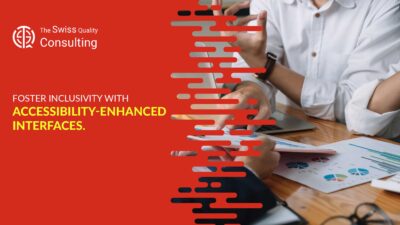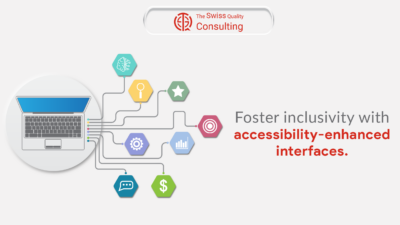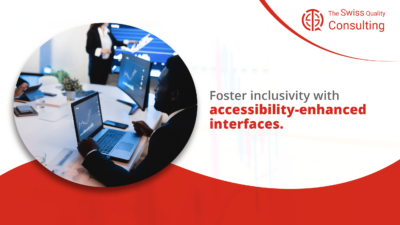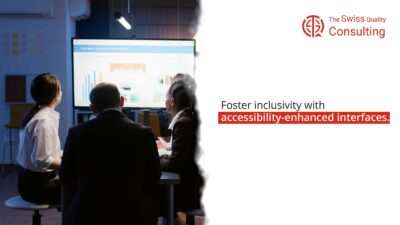Empowering Businesses for a Diverse and Inclusive Future
In today’s rapidly evolving business landscape, fostering inclusivity isn’t just a moral imperative; it’s also a strategic advantage. The quote, “Foster inclusivity with accessibility-enhanced interfaces,” encapsulates the essence of this crucial aspect of modern business success. In this article, we will explore the significance of accessibility-enhanced interfaces, their role in change management, and how they contribute to creating inclusive organizations.
The Imperative of Inclusivity
Before delving into accessibility-enhanced interfaces, it’s essential to understand the broader context of inclusivity in the business world. Inclusivity goes beyond complying with legal requirements; it’s about creating an environment where every individual, regardless of their abilities or background, can fully participate and contribute to the organization’s success.
Accessibility-Enhanced Interfaces: A Pathway to Inclusivity
Accessibility-enhanced interfaces refer to digital platforms, websites, and applications designed to be usable by people with disabilities. These interfaces prioritize accessibility features that ensure everyone can access and interact with digital content. Here’s why they are pivotal:
1. Expanding Your Reach
Accessibility-enhanced interfaces broaden the reach of your business. By making your digital assets inclusive, you tap into a larger and more diverse audience. This not only enhances your brand reputation but also opens new market opportunities.
2. Compliance and Risk Mitigation
Ensuring your digital presence is accessible is not only a moral obligation but often a legal requirement. Non-compliance can lead to legal issues and reputational damage. Accessibility-enhanced interfaces help you mitigate these risks.
3. Enhanced User Experience
Accessibility features, such as screen readers, alternative text for images, and keyboard navigation, not only benefit people with disabilities but also improve the overall user experience for everyone. A more user-friendly interface can boost customer satisfaction and loyalty.
4. Competitive Advantage
Inclusivity is a competitive advantage in today’s market. Organizations that prioritize accessibility demonstrate their commitment to diversity and inclusion. This can resonate with consumers and partners who value socially responsible businesses.
Embracing Change Management through Accessibility
Change management is an integral part of any organization’s journey towards inclusivity. Implementing accessibility-enhanced interfaces involves change at multiple levels, and effective change management is essential. Here’s how it plays out:
1. Identifying the Need for Change
Recognizing the need for accessibility-enhanced interfaces is the first step. This often comes from understanding the barriers faced by people with disabilities when interacting with your digital assets.
2. Defining Change Objectives
Once the need is identified, organizations must set clear objectives for implementing accessibility enhancements. These objectives should align with broader inclusivity goals and customer expectations.
3. Selecting the Right Strategies
Implementing accessibility changes may involve redesigning websites, applications, or content. Choosing the right strategies and technologies is crucial to achieving accessibility goals efficiently.
4. Training and Awareness
Employees at all levels need to be aware of the importance of accessibility and trained in creating and maintaining accessibility-enhanced interfaces. Change management efforts should include educational initiatives.
5. Continuous Improvement
Change management doesn’t end with the initial implementation. It’s an ongoing process of monitoring, evaluating, and continuously improving accessibility features to meet evolving needs.
Case Study: Transforming User Experience with Accessibility
To illustrate the transformative impact of accessibility-enhanced interfaces, let’s examine a real-world case study:
Company ABC: Revolutionizing Accessibility
Company ABC, a global e-commerce giant, realized that its digital platforms were falling short in terms of accessibility. They identified the need for a comprehensive accessibility enhancement program.
Step 1: Assessing the Current State
The first phase involved conducting a thorough accessibility audit. Company ABC partnered with experts to assess their websites, mobile apps, and digital content for accessibility compliance.
Step 2: Setting Ambitious Goals
Based on the audit findings, Company ABC set ambitious accessibility goals, aiming to make their digital assets fully accessible to people with disabilities. They defined clear metrics and timelines for achieving these goals.
Step 3: Redesign and Implementation
The company embarked on a redesign process, revamping their digital interfaces to meet accessibility standards. This included incorporating features like alternative text for images, keyboard navigation, and compatibility with screen readers.
Step 4: Employee Training
To ensure the sustainability of these changes, Company ABC provided extensive training to their design and development teams. Employees gained a deep understanding of accessibility principles and best practices.
Results:
The impact of this transformation was significant:
Improved user experience for all customers.
Enhanced brand reputation for social responsibility.
Increased customer loyalty and trust.
Compliance with accessibility regulations.
Expanded market reach and revenue growth.
Leadership and Management Skills in the Pursuit of Inclusivity
The success of accessibility initiatives hinges on the leadership and management skills within an organization. Business executives, mid-level managers, and entrepreneurs must champion inclusivity and guide their teams effectively.
1. Visionary Leadership
Visionary leaders set the tone for inclusivity by articulating a clear vision and commitment to accessibility. They prioritize resources and align the organization with inclusivity goals.
2. Change Management Expertise
Change management skills are vital in implementing accessibility-enhanced interfaces. Leaders and managers must navigate resistance, communicate effectively, and ensure that accessibility is integrated into the organization’s culture.
3. Inclusivity Advocacy
Effective leaders advocate for inclusivity at all levels of the organization. They encourage employees to embrace accessibility as a core value and provide the necessary resources and support.
Generative Artificial Intelligence: Advancing Accessibility
As organizations strive to enhance accessibility, they can leverage Generative Artificial Intelligence (GAI) to augment their efforts. GAI can analyze vast amounts of data and provide insights for creating more accessible interfaces.
The Role of GAI in Accessibility
Generative Artificial Intelligence can assist in:
Analyzing user behavior and preferences to tailor interfaces for individual needs.
Identifying potential accessibility barriers and suggesting solutions.
Automating the creation of alternative text for images and captions for videos.
Predicting user needs and adapting interfaces in real time.
Conclusion
In conclusion, the quote “Foster inclusivity with accessibility-enhanced interfaces” encapsulates a powerful message for businesses in the modern era. Accessibility is not only about compliance but also about creating a diverse and inclusive environment where everyone can participate fully.
Accessibility-enhanced interfaces are not just a technological endeavor; they involve change management, leadership, and a commitment to inclusivity. Real-world examples, such as Company ABC, demonstrate that investing in accessibility can lead to improved user experiences, increased brand reputation, and business growth.
Effective leadership and management skills are essential in driving inclusivity initiatives, while Generative Artificial Intelligence can offer valuable insights and automation capabilities to advance accessibility efforts.
In a world that values diversity and inclusivity, businesses that foster inclusivity with accessibility-enhanced interfaces are not only meeting legal requirements but also positioning themselves as leaders in creating a more accessible and equitable future.
#Accessibility #Inclusivity #ChangeManagement #GenerativeAI #LeadershipSkills #BusinessSuccess #DigitalAccessibility #UserExperience























